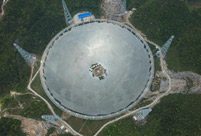

BEIJING, June 16 (Xinhua) -- China's homegrown navigation system, the BeiDou Navigation Satellite System (BDS), will cover the whole globe with a constellation of 35 satellites by 2020, said a government report on Thursday.
By 2018, the system is expected to provide basic services to the nations along the Belt and Road, as well as neighboring countries, said a white paper on the BDS issued by the State Council Information Office.
China aims to build "a world-class navigation satellite system" to meet the needs of the country's national security as well as economic and social development, and provide "continuous, stable and reliable" services for global users, the report said.
The country would like to "share the fruits of development in the field of satellite navigation, increasing the comprehensive application benefits of global navigation satellite system", it said.
China upholds the principles of "independence, openness, compatibility and gradualness" in developing the BDS, it said.
-- It will uphold independent construction, development and operation of the BDS, and acquire the capability to independently provide satellite navigation services to global users.
-- It will provide open satellite navigation services free of charge, and encourage all-scale, multilevel and high-quality international cooperation and exchange.
-- It will enhance BDS compatibility and interoperability with other navigation satellite systems.
-- It will carry out the BDS project step by step, enhancing the system's service performance and boosting the satellite navigation industry in a comprehensive, coordinated and sustainable manner.
China's BDS project is made up of three steps. The first step started in 1994 and was completed in 2000 with a test system coded "BDS-1" providing users in China with positioning, timing, wide-area differential and short message communication services. For the BDS-1, China launched two Geostationary Earth Orbit (GEO) satellites in 2000 and the third in 2003.
The second step led to a more established system coded "BDS-2" which started in 2004. By the end of 2012, a total of 14 satellites - five GEO satellites, five Inclined Geosynchronous Satellite Orbit (IGSO) satellites and four Medium Earth Orbit (MEO) satellites - were launched to complete the constellation.
The BDS-2 added the passive-positioning scheme and provided users in the Asia-Pacific region with positioning, velocity measurement, timing, wide-area differential and short message communication services.
The third step, aiming to complete a fully-established BDS, started in 2009 and will be finished by 2020.
According to the report, thanks to a hybrid constellation consisting of satellites in three kinds of orbits, the BDS operates more satellites in high orbits and offers better anti-shielding capabilities than other systems, particularly observable in terms of performance in the low-latitude areas.
It provides navigation signals of multiple frequencies with better accuracy and integrates navigation and communication capabilities for the first time, which enables five major functions including real-time navigation, rapid positioning, precise timing, location reporting and short message communication.
 Five made-in-China hi-tech breakthroughs
Five made-in-China hi-tech breakthroughs Beijing Style: Hot pants
Beijing Style: Hot pants HK-Zhuhai-Macao Bridge to open to traffic
HK-Zhuhai-Macao Bridge to open to traffic China opens its first combined transport service to Nepal
China opens its first combined transport service to Nepal Students take stylish bikini graduations photos
Students take stylish bikini graduations photos Charming dancing students pose for graduation photos
Charming dancing students pose for graduation photos Guizhou, Yunnan section of Shanghai-Kunming railway connected
Guizhou, Yunnan section of Shanghai-Kunming railway connected Naked models transformed into landscapes, birds and even DRAGONS by body painting artist
Naked models transformed into landscapes, birds and even DRAGONS by body painting artist World’s biggest cruise ship Harmony of the Seas to start maiden voyage
World’s biggest cruise ship Harmony of the Seas to start maiden voyage Top 20 hottest women in the world in 2014
Top 20 hottest women in the world in 2014 Top 10 hardest languages to learn
Top 10 hardest languages to learn 10 Chinese female stars with most beautiful faces
10 Chinese female stars with most beautiful faces China’s Top 10 Unique Bridges, Highways and Roads
China’s Top 10 Unique Bridges, Highways and Roads Abortive careers
Abortive careers West traps itself by politicizing lone wolf
West traps itself by politicizing lone wolf Lenders threaten borrowers with nude pics
Lenders threaten borrowers with nude pics Local dog meat festival shouldn’t be canceled forcefully
Local dog meat festival shouldn’t be canceled forcefullyDay|Week